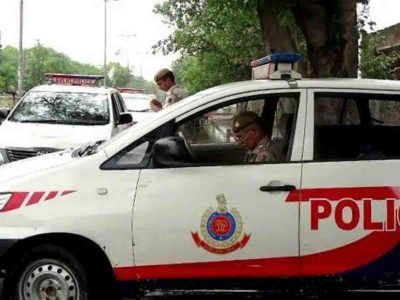“I have a plastic bag made of sugarcane but it is not very durable. That’s why I use this [polythene bag],” says Rajesh while pulling out a white coloured bag, stamped with a green biodegradable mark.
“We stopped using polythene for a while. It got a bit expensive, but the bag was back in the market a few months later,” he adds.
He has been selling vegetables in Noida, Uttar Pradesh for over four years. He remembers, last year around the same time, some officials fined him for selling vegetables in a single-use plastic polythene.
He now keeps both kinds of bags, the biodegradable one in case officials return and the other one for business.

Around a year ago, on July 1, 2022, the Ministry of Environment, Forest and Climate Change (MoEFCC) banned 19 identified single-use plastic items. These included carry bags (with thickness less than 120 mm), straws/stirrers and cutlery among others.
Following the ban, the market was flooded with alternatives to these single-use plastic products. However, plastic returned to the shelf soon.
A year after the ban, Patriot visited markets in Delhi-NCR to understand the effectiveness of the ban.

When asked about the continued use of polythene bags despite the ban, Rajesh said, “The consumer asks for these. The ones made from sugarcane are not durable. I have to give them the plastic one, otherwise my business would get impacted.”
He is not alone; a shopowner, who owns a sweets shop in Noida, faced a similar dilemma.
“The paper straw costs me more. Still, I am ready to use it instead of a plastic one. But most sellers are using the plastic straw ever since the it has returned to the market.”
He says that a normal plastic straw packet costs Rs 30. It has 150-200 straws. The paper one costs Rs 1 for each straw.

“The government puts a ban, officials fine us for using these, but no one questions the big traders and manufacturers,” he said while mentioning Delhi’s Kondli and Sadar Bazaar.
As per industry estimates, India produced over 20 million tonnes of plastic in 2021– 22. In the last 30 years, India’s plastic consumption has increased by over 23 times.
The ban imposed by the government in July 2022, received praise but a recent report by Centre for Science and Environment, a Delhi based environment think tank, highlighted the continued use of single-use plastic.
The survey revealed that carry bags were reported more than any other banned single-use plastic item. More than a third of the SUP items reported were carry bags (35.53%), almost a fourth were plastic straws (22.38%), and cutlery was the third-highest reported banned SUP items (18.42%).

Patriot visited Kondli, one of the big plastic markets of Delhi. Though the market had alternatives like paper and wooden products but banned single-use plastic could be seen over the shelf of most of the sellers.
One such seller, who wished to remain anonymous, told Patriot, “We are selling these because there is still demand for plastic products. Why can’t the government hold those who are responsible for manufacturing these?”
He explains that the demand for plastic alternatives has increased manyfold. But a few buyers still demand plastic carry bags, straws and other products. Municipal Corporation of Delhi officials fine, but they choose to remain silent over the illegal factories manufacturing these in Narela (North Delhi).
The CSE report concurs, stating, “The ban on single-use plastics in India is half-hearted and ambiguous. It gives manufacturers of banned single-use plastic items avenues to escape penalties for violations, and makes it difficult for State Pollution Control Boards (SPCBs) to penalise manufacturers.”
Moreover, there is no data on the number of manufacturers and/or producers who were fined either by the SPCB/PCC or by CPCB.
The enforcement campaign, non-compliance with the ban on identified single-use plastics was found in commercial establishments, including small shops in local markets.

Most of the updates from the authorities revolve around the inspections done in local markets and among street vendors. Enough has not been done — or at least reported — to stop the production of single-use plastics at the source. As per available information, the penalty levied during the enforcement campaigns was approximately Rs 5,81,78,001 (Rs 5.82 lakh approx.), and 7,75,577 kg of material was seized.
Siddarth Ghanshyam Singh, Programme Manager at the Solid Waste management team, CSE, said, “India has banned just 19 single-use plastic items. The banned items collectively make for just 2-3% of the entire single-use plastic in India.”
Thus, to say that India has banned single-use plastic would be “inaccurate” and “misinformed”.
Calling the ban “favourable” to big corporates and Fast Moving Commercial Goods (FMCGs), he further highlighted how many low utility items had comparatively high environmental impact.
One such example highlighted in the report is of cigarette filters, which despite being one of most littered items, was not included in the list of banned items. Instead, items like cigarette overwrap film were included.
Commenting on the issue of less availability of plastic alternatives, he added, “Stoppage in using is not really the solution. One has to put an end to it at the supply side which absolutely is not happening.”
We need more awareness and have to make these alternatives more affordable.





